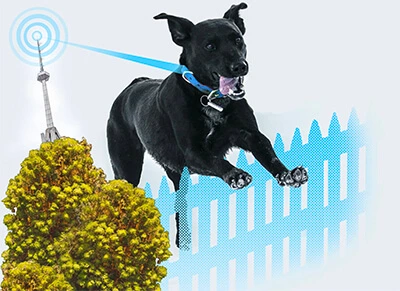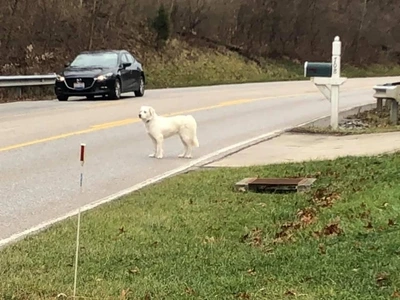You may have heard or read in your wireless fence manual that metal objects can block the wireless fence signal.
We’re frequently asked, “does a metal roof interfere with a wireless dog fence?”
A house with a metal roof can interfere with a nearby wireless dog fence. Metal roofs, or any large metal objects, can disrupt the signals the wireless dog fence depends on.
Let’s explore a little more about how and why this happens, and take a look at your options if your house has a metal roof.
Does a Metal Roof Interfere With a Wireless Dog Fence?
A metal roof, or any kind of large metal object for that matter, can disrupt the radio signals of the wireless fence.
These disrupted signals can cause any number of problems with your electric fence.
The boundary line may not stay set to where you place it.
A metal roof could cause the signal to jump around, making the boundary line much farther, or closer in than it should be.
Disrupted radio signals could cause your dog could be shocked even if they are in the yard.
A metal roof could cause the signal to jump, triggering the electric shock even though your dog hasn’t left the yard.
Both a moving boundary line and a disrupted radio signal can cause many problems:
- Your dog may experience a lot of confusion, harm, and stress from unnecessary shocks.
- Your dog may flee the yard because he gets scared by the shocks.
- Your dog may get the “Front Porch Syndrome”, where he refuses to leave the house, the porch, or his dog house because he fears getting shocked.
- The confusing shocks and moving boundaries will undo weeks of training on the fence.
Clearly, a metal roof that can cause that kind of interference will not go well with a wireless fence.
Can I Use a Wireless Dog Fence with a Metal Roof?

We do not recommend using a wireless dog fence if your house has a metal roof.
If your metal roof interferes with your wireless dog fence, not only will your fence be useless, but it will cause more harm than good.
If he has a bad experience with one wireless fence, your dog may struggle with any other kind of wireless or underground fence in the future.
With that being said, some fences are designed to keep electric dog fence interference at a minimum with special radio frequencies.
Sales representatives for individual fence manufacturers will be able to answer specific questions about their fence, and metal roof interference.
If you still want to use an invisible fence system on a property that is not a good candidate for wireless fencing, we recommend installing an in-ground invisible fence.
It’s easier than you think!
What Else Can Interfere with a Wireless Dog Fence?

Metal roofs are not the only thing that can interfere with a wireless dog fence.
There are numerous other objects that can cause problems with the electrical signals a wireless fence depends on:
Too Many Trees or Bushes
If your yard has many large trees or bushes in the way, they can block the signal coming from the transmitter, and interfere with both the fence boundaries and the receiver collar.
A Steep Hill
A rapid elevation change can disrupt the signal from the transmitter, causing problems with the boundary line, and the electrical signals that are being sent.
The transmitter needs to be on the same plane as the ground to work.
Aluminum Siding
Just like a metal roof, aluminum siding on your house can also disrupt the signals of a wireless dog fence, and cause the signal to bounce.
Metal Objects in Your Yard
Any kind of large metal object in your yard, such as a shed, will interfere with the fence.
Even if your house doesn’t have a metal roof or aluminum siding, make sure you don’t have any large metal objects in your yard that could cause problems.
A shed may block the signal leaving a dead space behind it that will have to be protected some other way.
Neighboring Fences
If your neighbor also has a wireless fence that is close to yours, signals from both transmitters can get mixed up.
This may allow your dog and your neighbor’s dog to freely roam into each other’s yards without receiving the shocks they’re supposed to when they leave their yard.
Based on the environment and setup of the yard, wireless fences can be fairly unreliable if there is too much interference.
If this is the case for your yard, a wireless fence may not be worth the easy installation and low cost.
Here’s a quick video explaining home and landscaping features that may interfere with a wireless dog fence signal:
What is the Invisible Fence Alternative?
If your yard is not going to work for a wireless dog fence, there is an alternative: a wired fence.
(We tested the best in ground dog fence options so be sure to check those out)
A wired invisible dog fence works similarly to a wireless fence, except that instead of signals sent from a transmitter set to a certain boundary length, you will have a wire buried around the perimeter of your yard.
This wire will communicate electronically with your dog’s receiver collar, and it will deliver warning beeps or shocks as your dog approaches or crosses the boundary line.
There is significantly less chance for interference with these types of invisible fences because they don’t receive signals from a long-distance transmitter.
Therefore, they are considered to be much more reliable than wireless fences, especially if your house has a metal roof or aluminum siding, or if you have too many large objects in your yard.
While the wired fence takes a bit longer to install, and requires some effort to lay and bury the wire, the results are reliable.
- Bury the wire wherever you want. You don’t have to settle for a small circle for your dog. You can set the fence to the perimeter of your property, up to 5 acres, with a single transmitter and extra wire.
- The wire only needs to be buried about 1-3 inches deep. No trenching is required. Make a slit in the ground and put the wire in.
- Most wireless dog fences cap out at about 1/2 acre. You have to purchase extenders to make a peanut-shaped place if you want more room for your dog to play. Wired fences can expand in a logical shape.
- You don’t have to worry about your building materials, landscaping features, or the incline of the property. Anywhere the wire is buried is off-limits for the dog.
- You can create safe zones in the fence by creating twisted-wire areas that the dog can cross without correction.
- The overall cost to install a wired dog fence as a DIY project is very low.
If you have a small urban or suburban yard that can be easily fenced with a circular wireless fence, then it’s the easiest way to make an invisible perimeter to keep your dog home.
If you have outbuildings, robust building materials, metal roofing or siding, or large metal objects in the vicinity of the transmitter, then an in-ground wired fence is the way to go.
See our related article, How Deep is an Invisible Fence Buried?, for extra installation tips!
How to Reduce Interference With a Wireless Fence

In many cases, the wireless fence will work fine with the exception of an area where a car is parked, or there is a small shed by the back fence.
In this case, you can try to reduce the odds if interference.
- Keep all metal objects at least 3 feet away from the transmitter.
- Place the transmitter near a window, on the outside of your house, or as close to the yard as possible with few walls in between. It must be protected from weather.
- Place the transmitter in a spot with few bushes and trees between it, and the boundary line.
- Try to set your boundary in the flattest spot of your yard, where no large hills can interfere with the electrical signals.
By following these tips, your invisible fence should operate properly with no interference.
Final Thoughts
If your house has a metal roof or aluminum siding, consider choosing a wired invisible dog fence instead of a wireless fence.
There are a lot of great wired fences out there on the market for you to choose from, and they will be significantly more effective at giving your pup a safe yard to play in.


